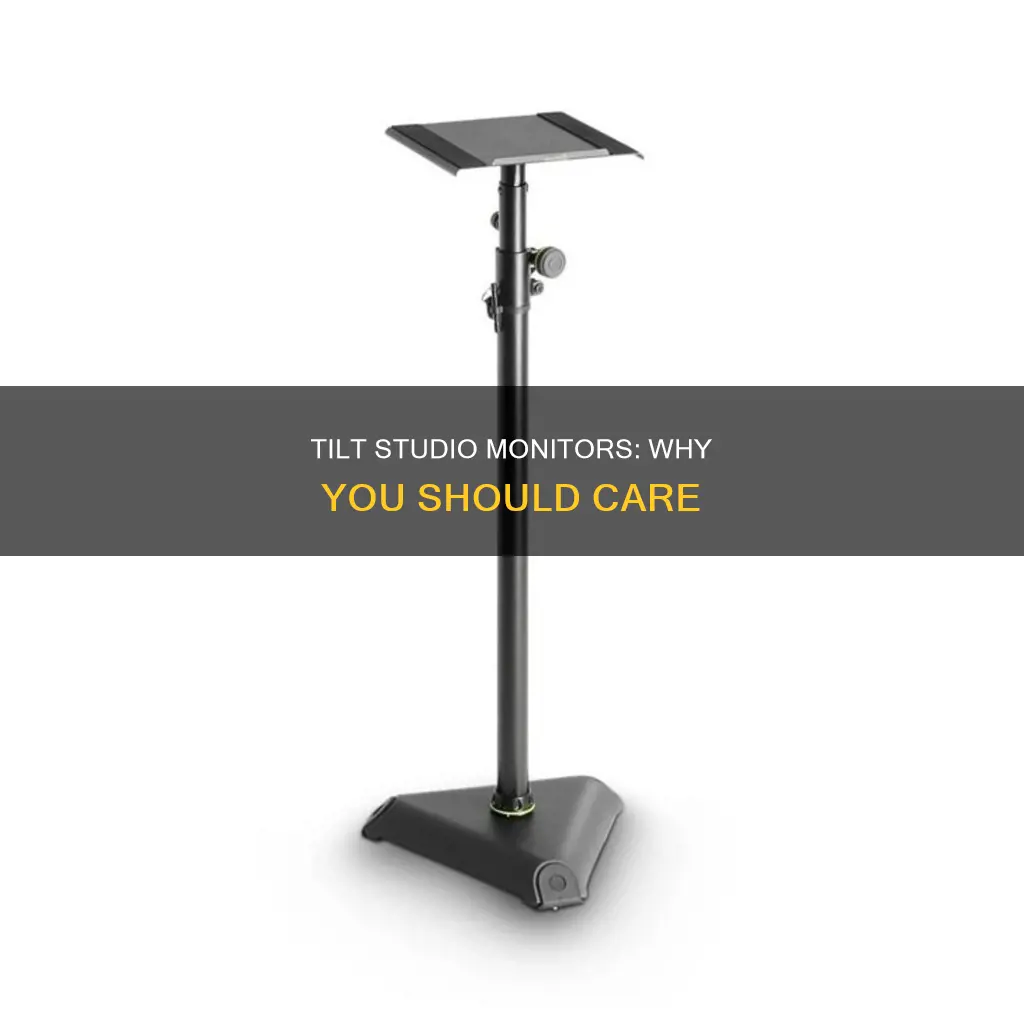
Studio monitor placement is crucial to achieving the desired sound quality in a recording studio. One of the key considerations is the tilt of the monitors, which can impact the accuracy of the stereo image and the overall listening experience. By tilting the monitors, users aim to direct the sound directly towards their ears, reducing unwanted reflections and optimising the sweet spot for monitoring. The ideal tilt angle is suggested to be around 15 degrees, as a more significant tilt can cause changes in frequency response as the listener moves slightly back and forth. Additionally, the height of the monitors and their distance from walls are also important factors in studio monitor placement, contributing to the overall sound quality and balance.
What You'll Learn

Tilt to point tweeters at ears
Studio monitors are the crux of any recording studio, and getting them in the right position is key to ensuring consistent results from your mixes. One of the most important steps in achieving good sound is monitor placement.
The ideal studio setup is to have your speakers make an equilateral triangle around your seat position, with your two speakers as the base of the triangle and your work position at the head. This helps create an accurate stereo image and a balanced soundstage.
To achieve the best listening quality, the ideal height for freestanding equipment that is not tilted down is at least 47 inches from the floor, with the tweeters aimed directly at your ears. If you want to tilt your speakers down, opt for about a 15-degree tilt but no more than that to avoid changing the frequency.
Tilting the monitors allows you to readjust the angle towards your head as you raise or lower the height. Isolation pads for your monitors are a great way to acoustically isolate them from the desk and easily adjust the tilt.
If your desk is a bit high or too low for your speakers, height-adjustable monitor stands are a good option. This is the ultimate choice if you want to be able to adjust everything in your configuration.
Monitor Sizes: Common Display Dimensions for Your Setup
You may want to see also

Avoid bass build-up
Studio monitors are an essential component of any recording studio, but their placement is just as important as the monitors themselves. Poor placement can result in huge peaks and valleys in the frequency response of your room, destroying any chance of a well-balanced mix. One common issue with monitor placement is bass build-up, which can be caused by several factors. Here are some tips to avoid bass build-up and achieve optimal sound quality:
Speaker Positioning
The placement of your studio monitors in relation to your listening position is crucial. The ideal setup is to form an equilateral triangle, with your head at the apex of the triangle and the monitors at the base. This ensures a consistent listening perspective and stereo image width. It is also important to avoid placing your monitors directly against the wall, as this can result in a heavy bass response. Aim for at least a foot or two of distance between the monitors and the walls.
Room Modes
The dimensions of your room can greatly affect the sound produced by your studio monitors. When the room's dimensions are the same length as a sound wave or a multiple of its half-wavelength, standing waves can occur, causing bass build-up. To minimise this issue, vary the distances between your monitors and each wall. Place the monitors against the longest wall and ensure the distances from the sidewalls are not the same or a multiple of the distance from the rear wall.
Monitor Height and Tilt
The height of your studio monitors and their tilt angle can also impact bass response. The ideal height for free-standing monitors is at least 47 inches from the floor, with the tweeters aimed directly at your ears. If you need to tilt the monitors, a slight downward angle of no more than 15 degrees is recommended. Larger tilts can cause changes in frequency response as you move slightly back and forth.
Acoustic Treatment
Adding acoustic treatment to your studio can help minimise bass build-up. Bass traps placed directly behind each monitor can significantly reduce reflected bass frequencies from the rear wall. Additionally, absorption panels or acoustic panels placed at initial reflection points above your head and on the sidewalls can help reduce reflected sound.
Monitor Type
The type of studio monitors you use can also make a difference. Monitors with front bass ports, such as the Adam Audio A7X, direct more energy forward, away from the walls. This can be especially beneficial in small rooms, as it allows for closer placement to the wall while reducing bass build-up.
By following these tips and carefully considering the placement and configuration of your studio monitors, you can effectively avoid bass build-up and achieve a more accurate and balanced sound in your studio.
How Multiple Monitors Affect Your Computer's Performance
You may want to see also

Reduce unwanted reflections
Reducing unwanted reflections is a crucial aspect of studio monitor placement and acoustic treatment. Here are some detailed instructions to achieve that:
Positioning the Monitors:
- Place the monitors symmetrically within the room to maintain an even sound field.
- Avoid putting monitors close to walls, especially corners, to prevent bass buildup. Keep them at least a few feet away.
- The ideal height for freestanding monitors is such that the tweeters are at ear level when you're seated. This ensures clearer sound reproduction.
- Angle the monitors slightly inward so they directly face your ears. Avoid excessive tilting up or down to prevent sound distortion.
- Isolation pads can be used to tilt the monitors and reduce desk vibrations.
Acoustic Treatment:
- Treat the room with acoustic panels, bass traps, and diffusers to reduce unwanted reflections and enhance sound clarity.
- Acoustic foam panels on walls help absorb unwanted frequencies and reduce echo.
- Bass traps, especially in corners, manage low-frequency buildup, preventing muddy sound.
- Diffusers break up sound waves, creating a more natural listening environment by preventing harsh reflections.
- Use monitors with front bass ports, which direct more sound energy forward, away from walls.
Monitor Placement Techniques:
- The Equilateral Triangle Rule: Position the monitors and your listening position to form an equilateral triangle. This ensures direct sound from each monitor reaches your ears simultaneously, creating a balanced sound environment.
- The 38% Rule: Place your listening position at 38% of the room's length to reduce unwanted reflections and achieve a balanced bass response.
Advanced Techniques:
- Room correction software: This software addresses room anomalies by analyzing acoustics and adjusting monitor frequency output for a more balanced sound.
- Calibration: Calibrate your monitors using an SPL meter to measure sound levels effectively and ensure accurate sound reproduction.
Enhancing Productivity with Multiple Monitors: A Comprehensive Guide
You may want to see also

Maintain consistent listening perspective
Studio monitors should be tilted to maintain a consistent listening perspective. This is achieved by forming an equilateral triangle with the monitors and the listener's head, ensuring the tweeters are aimed at the listener's ears. The equilateral triangle setup helps create an accurate stereo image and a balanced soundstage, optimising the "sweet spot" for monitoring.
To maintain this consistent listening perspective, it is crucial to position the studio monitors correctly. Firstly, the monitors should be placed at ear level or slightly above, allowing the sound to be directed accurately towards the listener's ears and reducing unwanted reflections from surfaces. This can be adjusted using height-adjustable monitor stands or isolation pads, which also help to minimise standing waves between the front and rear walls.
Secondly, the distance between the monitors and the listener should be considered. In an ideal studio setup, the monitors should be about 2-3 feet from the listener and each other, creating an equidistant setup. This distance can be fine-tuned using dedicated speaker stands or monitor stands, ensuring the tweeters are aligned with the listener's ears.
Lastly, the placement of the monitors in relation to the walls is essential. Acoustic resonance can occur when monitors are placed in corners or against walls, leading to a buildup of low-frequency energy and an uneven frequency response. By positioning the monitors away from walls and corners, issues with sound reflections, phase cancellation, and imbalanced stereo imaging can be mitigated.
By following these guidelines and adjusting the tilt of the studio monitors, a consistent listening perspective can be achieved, resulting in a more accurate and balanced sound experience.
Patagonia's Performance Monitoring Strategies: Secrets to Success
You may want to see also

Prevent slippage
To prevent slippage when tilting studio monitors, it is important to ensure that the monitors are securely anchored and stabilised. Here are some methods to achieve this:
- Use monitor stands or isolation pads: Monitor stands or isolation pads can provide a stable base for your monitors and allow for height and tilt adjustments. Isolation pads, in particular, can help to acoustically isolate the monitors from the desk, reducing unwanted vibrations.
- Adjust the height and tilt: Ensure that the monitors are at the correct height, which is typically ear level or slightly above. Adjust the tilt angle to optimise the sound at your listening position. The recommended tilt angle is about 15 degrees; however, some users have achieved good results with tilt angles of up to 22 degrees.
- Secure with anchor or stabiliser stands: If you are tilting your monitors at a steeper angle, consider using anchor stands or stabiliser stands to prevent slippage. These stands are designed to securely hold the monitors in place and control the bass response.
- Use a separate stand: If desk space is limited, consider using a separate floor-standing speaker stand for one of your monitors. This can help free up space on your desk and allow for better positioning of the monitors in relation to your listening position.
- Avoid excessive tilt: While a slight downward angle is generally acceptable, excessive tilting of the monitors can lead to potential slippage. It is important to find a balance between the desired tilt angle and the stability of the setup.
By following these guidelines, you can help prevent slippage when tilting your studio monitors, ensuring a safe and secure setup for your audio equipment.
Monitored and Modeled Data: Finding RHC Ratios
You may want to see also
Frequently asked questions
Studio monitors are tilted to direct the sound towards the listener's ears, reducing unwanted reflections from surfaces.
Studio monitors can be tilted by adjusting the height of the monitor stands, or by using isolation pads.
The ideal height for studio monitors is at least 47 inches from the floor, with the tweeters aimed directly at the listener's ears.
Tilting studio monitors can help to minimize standing waves between the front and rear walls of the room, and improve the overall sound quality of the studio setup.







